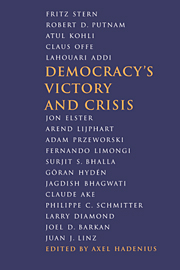Book contents
- Frontmatter
- Contents
- List of contributors
- Acknowledgments
- 1 Victory and crisis: introduction
- Part 1 Historical perspectives
- Part 2 Social and cultural aspects
- Part 3 Constitutional questions
- Part 4 Democracy and development
- 9 Democracy and development
- 10 Freedom and economic growth: a virtuous cycle?
- 11 Democratization and administration
- Part 5 Democracy and globalization
- Part 6 Promoting democracy
- Index
10 - Freedom and economic growth: a virtuous cycle?
Published online by Cambridge University Press: 13 October 2009
- Frontmatter
- Contents
- List of contributors
- Acknowledgments
- 1 Victory and crisis: introduction
- Part 1 Historical perspectives
- Part 2 Social and cultural aspects
- Part 3 Constitutional questions
- Part 4 Democracy and development
- 9 Democracy and development
- 10 Freedom and economic growth: a virtuous cycle?
- 11 Democratization and administration
- Part 5 Democracy and globalization
- Part 6 Promoting democracy
- Index
Summary
Abstract
This chapter investigates the relationship between freedom and economic growth. Two components of freedom are considered – political and economic. While political freedom measures have frequently been used, this chapter offers three separate variables to measure a major, and much neglected, determinant of economic growth – namely, economic freedom. The relationship of freedom with respect to welfare is examined through the use of five separate indicators of welfare: – per capita income growth, measured in constant dollars and purchasing power parity (PPP) dollars; total factor productivity growth (TFPG); growth in secondary school enrollment and decline in infant mortality. Data for over ninety countries are used for the time period 1973–1990.
The results are robust and invariant to alternative specifications. In particular, both political and economic freedom are positively associated with economic growth. For example, a 1 point increase in political freedom (on a 7 point scale) leads to an increase in per capita growth of approximately 1 percent; and an opening up of international capital markets (as proxied by the black market premium on the currency) leads to an increase of 1.6 percent in the per capita growth rate. These results hold regardless of whether the estimation is ordinary least squares (OLS) or in the context of a simultaneous equation model. Further, the results hold for all three educational attainment variables (World Bank 1991; Barro and Lee 1992, 1993b; and Nehru, Swanson, and Dubey 1993).
One reason why these results differ markedly from the “no (or negative) freedom-growth” relationship observed in the literature is because of the improved specification of the growth model developed in this paper, i.e., a model which incorporates both economic and political freedom.
- Type
- Chapter
- Information
- Democracy's Victory and Crisis , pp. 195 - 241Publisher: Cambridge University PressPrint publication year: 1997
- 12
- Cited by



